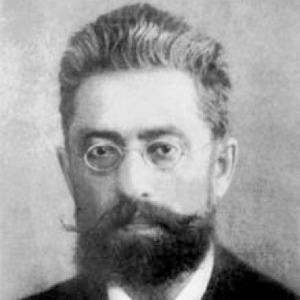- Surname:
- Kandinsky
- First name:
- Victor Khrisanfovich
- Era:
- 19th century
- Field of expertise:
- Neurology
Psychiatry - Place of birth:
- Biankin (RUS)
- * 24.03.1849
- † 03.07.1889

Kandinsky, Victor Khrisanfovich
Russian psychiatrist, described the psychopathology of hallucinations.
Life
Victor Kandinsky (1849-1889) was born in Byankino, Siberia, and grew up in a large family of wealthy businessmen; the painter and art theorist Wassily Kandinsky was his second cousin.
He studied medicine in Moscow from 1867 to 1872 and then worked as a physician at the local Wremenaja Hospital. While serving as a naval doctor on Russian battleships during the Russo-Turkish War, he began experiencing depressions and hallucinations and was twice committed to a military hospital in St. Petersburg for psychiatric treatment for psychosis (in May 1877 and October 1878). He married an ethnic German nurse who worked at this clinic. Kandinsky was among the founding members of the Moscow Medical Society. He assumed a post as a physician at St Nicholas Asylum in Saint Petersburg in 1881 where he engaged in research on psychopathological, nosological and forensic issues, the results of which he published in 1881 and 1885. He was elected secretary of the first Russian psychiatric congress in 1887.
Having suffered another nervous breakdown in 1883, he never fully recovered and continuously experienced severe depressions. In September 1889, at the age of 40, Victor Kandinsky died of an overdose of opium consumed during a depressive episode.
Work and legacy
Kandinsky’s research on the psychopathology of hallucinations was groundbreaking (e.g., in differentiating between hallucinations and “pseudohallucinations” or in examining the ways in which patients can actively cope with their hallucinations). He wrote a book about his own psychotic experiences, which he published first in Russian (1880) and then in German (1881; Zur Lehre von den Halluzinationen [On the Study of Hallucinations]). He described how he became accustomed to his hallucinatory experiences, increasingly developed the ability to distract himself from these sensations and eventually managed to classify them as unreal – a development that he actively advanced with the help of intense intellectual activity (1881: 461 f.). Kandinsky’s self-reflexive study already indicates the differentiation between hallucinations and pseudohallucinations, as laid out in detail in his 1885 monograph Kritische und klinische Betrachtungen im Gebiete der Sinnestäuschungen (Critical and Clinical Reflexions in the Field of Hallucinations), now regarded a classic in the research of hallucinatory sensations (Spitzer 1987). In the tradition of Theodor Meynert, Kandinsky explained hallucinations as the result of an imbalance between “hypersensitive sensory nerves”, on the one hand, and “a weak inhibitory activity of the forebrain”, on the other (Brückner 2007: 148). In a text published posthumously by his widow in 1890, Kandinsky described – again based on his own experiences – a delusional syndrome that was later named after him and the French physician Gaëtan Gatien de Clérambault (1872-1934) (“Kandinsky-Clérambault Syndrome"; cf. Lerner, Kaptsan & Witztum 2003).
Literature
Brown, J. V. (1994): Heroes and non-heroes. Recurring themes in the historiography of Russian-soviet psychiatry. In: S. Micale, R. Porter (eds.): Discovering the history of psychiatry. New York: Oxford University Press, pp. 297-310.
Brückner, B. (2007): Delirium und Wahn. Geschichte, Selbstzeugnisse und Theorien von der Antike bis 1900. Vol. 2. 19. Jahrhundert – Deutschland. Hürtgenwald: Pressler.
Kandinsky, V. (1881): Zur Lehre von den Hallucinationen. In: Archiv für Psychiatrie und Nervenkrankheiten 11, pp. 453-464.
Kandinsky, V. (1885): Kritische und klinische Betrachtungen im Gebiete der Sinnestäuschungen. Berlin: Friedländer.
Lerner; V., E. Witztum (2003): Victor Kandinsky, MD. Psychiatrist, researcher and patient. In: History of Psychiatry, 14, pp. 103-111.
Lerner, V., A. Kapstan, E. Witztum (2003): Kandinsky-Clérambault's syndrome: concept of use for Western psychiatry. In: The Israel Journal of Psychiatry and Related Sciences 40, (1), pp. 40-46.
Lerner; V., E. Witztum (2006): Victor Kandinsky, M.D., 1849-1889. In: American Journal of Psychiatry, 163, pp. 209.
Lerner, V., J. Margolin, E. Witztum (2012): Victor Kandinsky (1849-89). A pioneer of modern Russian forensic psychiatry. In: History of Psychiatry 23, (2), pp. 216-228.
Schmidt-Degenhard, M. (1992): Die oneiroide Erlebnisform. Zur Problemgeschichte und Psychopathologie des Erlebens fiktiver Wirklichkeiten. Berlin: Springer.
Spitzer, M. (1987): Pseudohalluzinationen. In: Fortschritte der Neurologie und Psychiatrie 55, (3), pp. 91-97.
Zilboorg, G. (1943): Russian psychiatry – its historical and ideological background. In: Bulletin of the New York Academy of Medicine 19, (October), pp. 713-728.
Catharina Bonnemann
Photo: unknown / Source: Wikimedia / [public domain].
Referencing format
Catharina Bonnemann (2015):
Kandinsky, Victor Khrisanfovich.
In: Biographisches Archiv der Psychiatrie.
URL:
biapsy.de/index.php/en/9-biographien-a-z/225-kandinsky-victor-khrisanfovitch-en
(retrieved on:14.07.2025)
